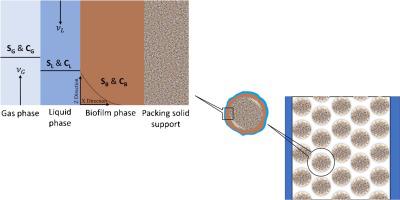Journal of Environmental Chemical Engineering ( IF 7.4 ) Pub Date : 2020-10-18 , DOI: 10.1016/j.jece.2020.104617 Mohammad Kalantar , Seyed Morteza Zamir , Milad Ferdowsi , Seyed Abbas Shojaosadati

|
The performance of biotrickling filters (BTFs) has been significantly affected during the co-treatment of volatile organic compounds (VOCs) with different hydrophilicities. Removal of toluene vapor as a hydrophobic compound in the absence and presence of methanol as a hydrophilic pollutant was studied in a BTF. The inlet loading ranges were 18−36 g.m−3.h−1 for toluene and 0−225 g.m−3.h−1 for methanol at constant empty bed residence time (EBRT) of 60 s. The removal efficiency of toluene (RET) varied from 30 to 80 %, while RE of methanol (REM) remained almost constant at > 90 % within different phases of experiments due to the unlimited solubility in water. A comprehensive dynamic mathematical model consisting of mass transfer through gas, liquid, and biofilm phases with the kinetic of biodegradation in the BTF and accumulation of methanol in liquid was developed. The interaction parameters were optimized by genetic algorithm and validated by experimental data. Sensitivity analysis on the optimized parameters showed that biofilm thickness and methanol interaction parameter had the most effects on RET as 45 % and 38 %, respectively. Model simulation showed that 43–90 % of biofilm depth was active for toluene degradation at different inlet gas-phase concentrations, indicating a diffusion-limited condition in the process. In contrast, all depth of biofilm was fully active for methanol degradation, showing a kinetic-limited regime dominant for methanol removal in the BTF under all operating conditions. Results showed that the developed model could effectively predict the dynamics of VOCs removals along with the determination of kinetic constants.
中文翻译:

存在甲醇蒸气的生物滴滤池中甲苯的去除:实验研究,数学建模和动力学参数优化
生物滴滤滤池(BTF)的性能在具有不同亲水性的挥发性有机化合物(VOC)的共处理期间受到了显着影响。在BTF中研究了在不存在和存在甲醇作为亲水性污染物的情况下去除甲苯蒸气作为疏水性化合物的情况。在60 s的恒定空床停留时间(EBRT)下,甲苯的入口负载范围为18-36 gm -3 .h -1,甲醇为0-225 gm -3 .h -1。甲苯(RE T)的去除率从30%到80%不等,而甲醇(RE M)由于在水中的无限溶解度,在不同实验阶段几乎保持恒定在> 90%。建立了一个综合的动力学数学模型,该模型包括通过气相,液相和生物膜相的传质,以及BTF中生物降解的动力学和甲醇在液体中的积累。通过遗传算法优化了相互作用参数,并通过实验数据进行了验证。优化参数的敏感性分析表明,生物膜厚度和甲醇相互作用参数对RE T影响最大。分别为45%和38%。模型模拟表明,在不同的入口气相浓度下,43-90%的生物膜深度对甲苯降解具有活性,表明该过程中存在扩散受限的条件。相比之下,所有深度的生物膜对于甲醇降解都是完全有效的,显示出在所有操作条件下BTF去除甲醇的动力学受限机制。结果表明,所开发的模型可以有效地预测VOCs的去除动力学以及动力学常数的确定。









































 京公网安备 11010802027423号
京公网安备 11010802027423号